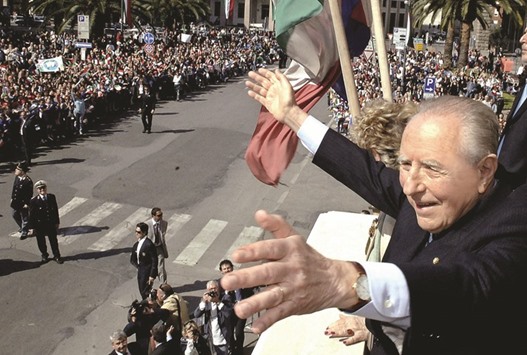Carlo Azeglio Ciampi, a widely respected former Italian president who played a crucial role in Italy’s adoption of the euro, has died at 95, Prime Minister Matteo Renzi announced yesterday.
Ciampi, who served briefly as prime minister in a 1993-94 caretaker government of technocrats, held the largely ceremonial post of president from 1999 to 2006.
He was so popular that he was widely urged to serve a second term – a proposal he declined on the grounds of his advanced age.
A career economist, Ciampi spent 14 years as governor of the Bank of Italy and later served as a treasury minister, a role in which he was the principal architect of Italy’s adoption of the euro as one of the founder members of the single currency.
He “served Italy with passion”, Renzi wrote on Twitter.
Foreign Minister Paolo Gentiloni hailed “a great Italian statesman”, and other tributes poured in from across the political spectrum.
A rare sour note was sounded by Matteo Salvini of the far-right Northern League.
He accused Ciampi of having “sold off Italy’s jobs, currency, borders and future”.
Ciampi was politically on the centre-left although he was not officially aligned to any party for the bulk of his career.
He took over as prime minister at a time when Italy was reeling as a result of a financial crisis and the fallout from the enormous “mani pulite” (“clean hands”) corruption scandal – a criminal investigation that led to half the country’s lawmakers being indicted for taking bribes.
It was also a time when tensions between the state and organised crime were running high with mafia mobsters attempting to pressure the government into being lenient with convicted bosses.
Ciampi’s successor as president, Giorgio Napolitano, testified in 2014 that Ciampi had feared a coup was underway when there was a blackout in his office early in his term as prime minister.
As president, Ciampi was credited with exercising a restraining influence on the authoritarian instincts of Silvio Berlusconi when the controversial media tycoon was prime minister.
Born in the Tuscan port of Livorno on December 9, 1920 into a family of opticians, Ciampi’s teachers included Jesuit priests and a prominent anti-fascist figure, Guido Calogero.
He served as a driver for the Italian army in Albania during World War II before joining the resistance to the regime of dictator Benito Mussolini on his return to Italy.
After the war, he graduated in law and began a 47-year career at the Bank of Italy which culminated in him getting the top job in 1979, the year the lira entered the European Monetary System, an exchange rate grid that was a predecessor to monetary union.
He leaves a widow, Franca, to whom he was married for 70 years, and two children.
Media reports said he had died after spending several weeks in a Rome hospital.

Ciampi waving to the crowd during a visit to his hometown of Livorno on May 3, 2006.
